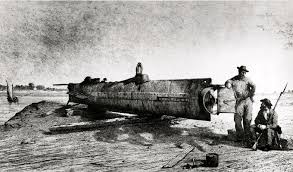The H.L. Hunley, Then and Now
On the chilly night of February 17, 1864, an odd looking, submersible vessel, slipped through Breach Inlet between the Isle of Palms and Sullivan’s Island toward the United States Navy’s blockading squadron about 5 miles beyond the mouth of Charleston Harbor. It was the H.L. Hunley, and when it had completed its mission, it would go down in history as the first submarine to successfully sink an enemy ship in combat. Although it had no impact on the outcome of the Civil War or ending the Union blockade, it altered naval warfare forever!

The Hunley was about 40 feet long and was manually propelled by a crew of 8 men who hand-cranked the propeller shaft. It was armed with one “torpedo” (stationary bomb) attached to a 20 foot spar extending from the bow, which was designed to detonate when ramming the torpedo into the enemy ship. As it approached the USS Housatonic it was only semi-submerged and spotted by Union sailors, who fired muskets at it in futile desperation.
The Hunley delivered its explosive payload into the hull of the Housatonic, causing a tremendous explosion, killing 5 Union sailors and sinking the ship in fairly shallow water. The Hunley sunk as well and its entire crew of 8 perished. Recent discoveries (2012) indicate that the Hunley’s torpedo may have exploded prematurely, causing the submarine to sink and be lost for almost 150 years, along with its crew. The question of what happened has been one of the most intriguing mysteries of the Civil War.
In 1970 the Hunley was discovered (and the discovery was confirmed in 1995) about 100 yards away from where the Housatonic went down. In 2000 in was raised and taken to the Warren Lasch Conservation Center in North Charleston. During the excavation and restoration of the submarine, a staff of researchers, led by Maria Jacobsen, found the remains of the 8 crew members and numerous artifacts, including a $20 gold piece belonging to the Hunley’s commander, George Dixon.
It is be interesting to note that the remains of the crew were seated at their stations and there were no signs of any struggle to escape the boat. They probably died from the concussion of the explosion of the torpedo or asphyxiation, or both. All have been identified and were buried in 2004 in Magnolia Cemetery after one of the largest and most attended funeral services and processions in Charleston history.
Work continues at the Lasch Conservation Center in an effort to not only preserve the vessel, but also to to solve the many mysteries surrounding this incident. One of the aspects of Charleston’s history which I find most fascinating is that there are still so many unanswered questions and stories to be investigated.
Visitors to Charleston can see the Hunley at the Lasch Conservation Center on Saturdays and Sundays. There are guided tours by volunteer docents. The actual vessel is preserved and on display in a tank of water, while a replica can be entered by the public. The fee is $12.00 and there are numerous exhibits. A visit to see the H.L. Hunley is well worth the time!
For additional information, the Friends of the Hunley have an excellent and informative website that you should visit as well!
